Climate change makes seas rise faster and faster
Only a small window of time remains to keep the worst impacts from happening
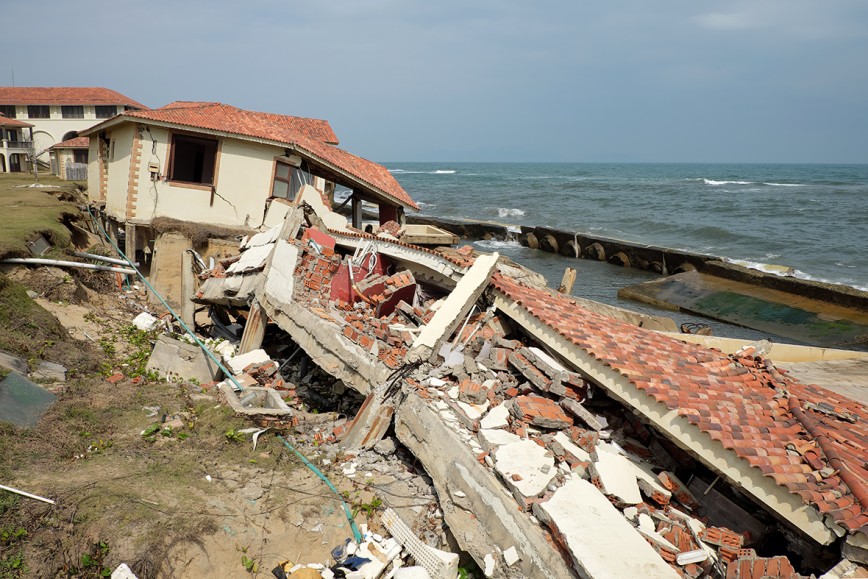
Rising seas eroded the coastline of this resort region in Hoi An, Vietnam, causing its buildings to crack apart and start tumbling into the water. Climate change is threatening low-lying regions across the globe with similar destruction.
xuanhuongho/iStockphoto
This is the fifth in a 10-part series about the ongoing global impacts of climate change. These stories will look at the current effects of a changing planet, what the emerging science suggests is behind those changes and what we all can do to adapt to them.
Newtok, Alaska, sits on a treeless, grassy plain near where the Ningliq River meets the Bering Sea. Home to 450 Yup’ik Eskimos, Newtok is not an old place. Most families have lived there only since the 1960s. The federal government built a school there back in 1958 as a way to encourage people to move to this village from surrounding areas.
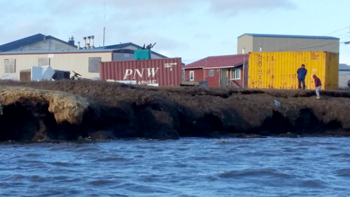
Now “their roots are ingrained in this little village,” says resident Romy Cadiente.
But climate change has put Newtok in danger. Ice here is melting. Its once-frozen land, known as permafrost, is sinking as the ice melts. The river is eroding the ground at a rate of 21 to 27 meters (70 to 90 feet) per year. And when a strong south wind pushes the tide in during the fall, “we know it’s going to flood,” Cadiente says. Homes closest to the shore are in danger of being washed away. If that happens, families would need to live in emergency yurts (a type of tent).
As the landfill and sewage lagoon have eroded, people here can no longer dispose of their trash. The villagers have other health worries, too. Mold grows well in their waterlogged homes. That caused breathing problems for residents.
People can’t keep living in Newtok, so they’re building a new village at Metarvik. It’s about 14 kilometers (9 miles) away. Cadiente is coordinating the work to build the new village and move to it. “The thing that’s really neat is [the people] get to stay together,” he says. Yet Newtok’s residents feel saddened at having to leave the homes their families have had for nearly 60 years.
Newtok isn’t the only place threatened by melting ice. Melted water from once-frozen land, glaciers and other places flows into the sea. That makes sea levels rise — not just in polar regions, but worldwide. Coastal areas and island nations around the globe are already dealing with the effects of rising seas. People can take some steps now to limit the worst impacts and help people adapt. But time to act is running short.


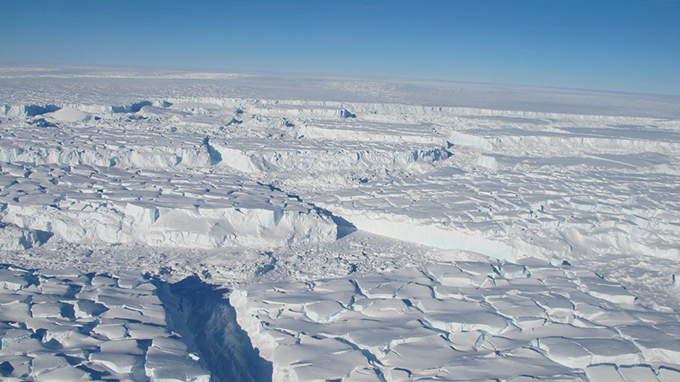
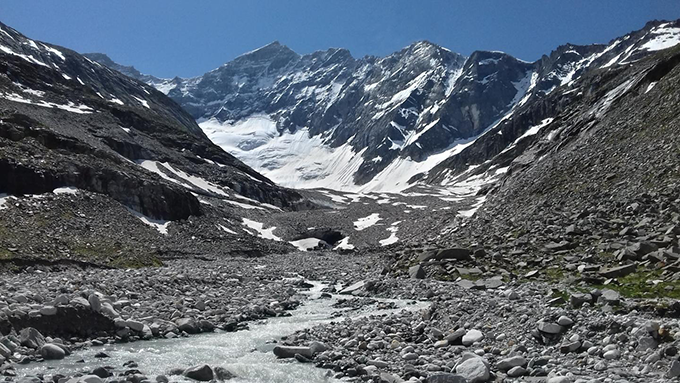
How climate change affects sea levels
Average sea levels around the world are rising for two main reasons. Rising air temperatures have been melting land-based ice — such as glaciers. That water eventually makes its way into the world’s oceans. And it accounts for about two-thirds of global sea level rise, says William Sweet. He’s an oceanographer at the National Oceanographic and Atmospheric Administration (NOAA) in Silver Spring, Md. The other third comes from the warming of seawater. Warmer water takes up more space. (That lower density of ice is the reason ice cubes float in your glass of water.)
Worldwide, sea levels are rising by some 3 millimeters per year. That’s about an inch every eight years, Sweet notes. It’s not a lot. But it can contribute to an array of problems, such as coastal flooding during high tides and bigger storm surges when hurricanes make landfall.
By 2100, though, the average global sea level will likely be between 0.3 and 2.5 meters (1 to 8 feet) higher than it was in 2000. That range comes from a January 2017 report from NOAA by Sweet and other scientists. The high figure is a worst-case scenario. It assumes people don’t make changes and that greenhouse-gas emissions keep going up. Even if humans stabilize emissions, average sea levels are likely to rise between 0.5 to 1 meter (1.6 to 3.3 feet) by 2100, Sweet notes.
And they’ll keep rising.
“The more [greenhouse gases] we emit, the more we commit” to even higher sea levels, says Peter Clark. He’s a geologist and climate scientist at Oregon State University in Corvallis. Sea level rise generally can’t be reversed once it happens. It takes time to lock water up in glaciers and ice sheets. So, Clark explains, “Even if we cap emissions now, sea level will continue to rise” for thousands of years.
Sea level rise isn’t equal around the world. Places in the eastern United States, southeastern Australia, eastern Asia and northern Europe are seeing rises that are higher than average. Rises in Western Africa and the U.S. Pacific Northwest are smaller. One reason is something known as glacial rebound. Sweet compares the effect to a big person rising from a foam mattress. During the last ice age, ice squished down large areas of land. That squished-down land has been slowly rising up since the ice melted. Other areas that had been pushed up now are sinking back down. Louisiana is one example of that. Earth’s rotation, gravity, natural climate patterns and other factors also play a part.
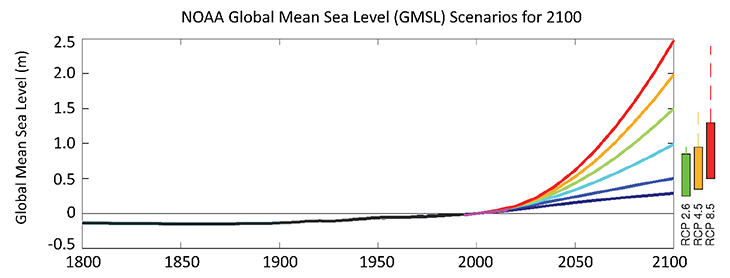
The rate of sea level rise isn’t constant. “Over the last 25 years, it’s double the rate that we’ve been seeing the previous century,” Sweet says. By 2100, the rate will be 10 millimeters (0.4 inch) per year or more, according to a February 2018 report in the Proceedings of the National Academy of Sciences. One reason is that climate change has feedbacks. Some effects cause more warming of the air and water, and that causes more sea level rise.
Also, the melting of land-based ice is speeding up. Smaller glaciers melt faster than big ones, so melting speeds up as they shrink. Meanwhile, by 2017, the rate of ice melt for Antarctica was almost triple what it had been from 1992 to 2011. That estimate comes from a June 2018 report in Nature.
Worries along the coast
More than half of the world’s largest cities sit in coastal areas. Large parts of some of them could be under water by the end of this century. Shanghai, China; Mumbai, India; Dhaka, Bangladesh; Lagos, Nigeria; Sao Paolo, Brazil and Jakarta, Indonesia are just a few places at risk. Low-lying island nations could completely disappear.
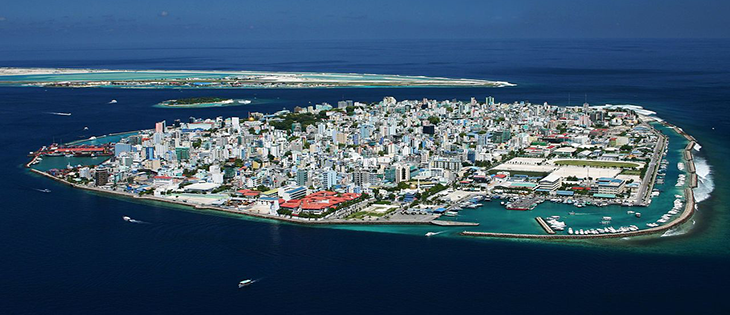
Sea-level rise won’t drown these nations in a steady, predictable constant rise of coastal waters. Instead, the water will rise in fits and spurts. Day-to-day weather plays a role. For example, the strong winds of a hurricane can cause a storm surge. That extra water sweeps onto land. Flooding is even worse if the surge coincides with the high tide.
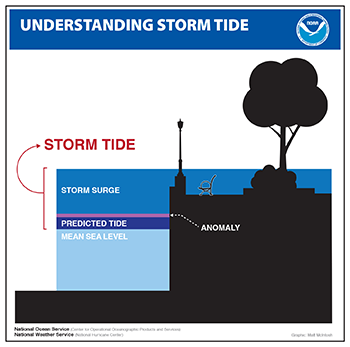
High tides are also causing more floods on sunny days. “Due to sea level rise, the annual number of days of high tide flooding is increasing at an accelerated rate,” Sweet notes. On average, U.S. high-tide floods happen 50 percent more often than they did 20 years ago. And those floods are twice as common now as they were 30 years ago. Sweet and his colleagues described that trend in a June 2018 report from NOAA. In other words, he says, “You’re getting wet, and you’re getting wet more often.”
It’s worse in some places than others. For example, high-tide floods in Miami, Fla., have increased fourfold in the 10 years ending in 2006. Florida researchers reported that in a 2016 study in Ocean & Coastal Management.
Water flowing over land isn’t the only problem. Sea level rise also can boost erosion. It can change groundwater levels. And it can back up drainage systems, even a couple of kilometers (1 to 2 miles) away. That means water on land can’t flow as easily into the sea. And if water can’t flow into the sea easily, floods last longer.
Sea level rise could be even worse than current projections. If all of Greenland’s ice sheet melts, for example, average sea levels could rise by an additional 7 meters (23 feet). Antarctica holds even more water locked up in its massive ice sheets.
Shifting habitats and rising seas
USGS/YouTube
Sea level rise will directly affect people. But when you factor in plants and animals, things get a bit more complicated. Climate change is altering whole ecosystems. The ranges for some species are expanding, shrinking or shifting. Some of those changing ecosystems might protect coastal areas. Others could worsen the impacts of sea-level rise.
Consider mangroves, for example. These woody trees and plants grow in salty, subtropical coastal areas. They reduce erosion of the land. They also help build soil, which elevates land levels a bit. Both of these things can help protect areas from sea-level rise.
As the climate warms, where mangroves grow will likely shift, says Samantha Chapman. She is an ecologist at Villanova University in Pennsylvania. Chapman can make that prediction based on an experiment published in the Journal of Ecology in August 2018. She and other scientists set up a greenhouse in part of a Florida wetland. At the start, a little more than one-third of each plot had mangroves. Most of the rest was a saltwater marsh. After two years in the warmer temperatures of the greenhouse, the mainly mangrove regions had expanded by about 25 percent. Meanwhile, the marshy areas shrunk.
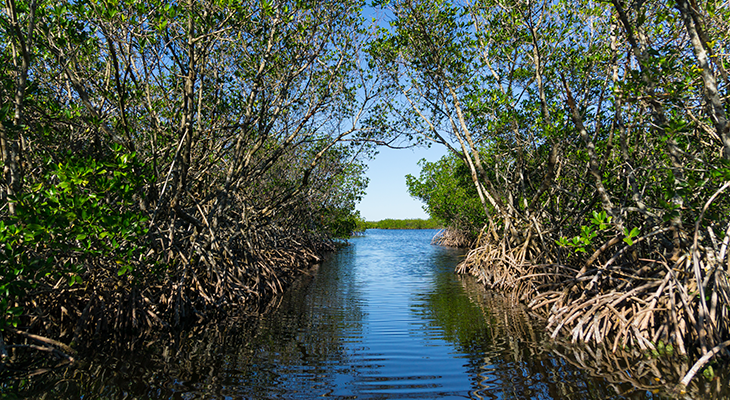
More mangroves could help build up coastal lands. That could slow coastal sea level rise. But there’s a catch. “There can still be some deep freezes,” Chapman says. Mangroves cannot survive freezing temperatures. Cold spells could wipe out young mangroves. And if mangrove trees had taken the place of sea grasses and other marsh plants, the coast could end up with less protection than before. “That’s something I worry about,” Chapman says.
Marshes are another important ecosystem. They help protect coasts from storms and erosion. They remove pollutants from the water. They provide breeding grounds for fish and other organisms. And they help limit the amount of greenhouse gases in the air.
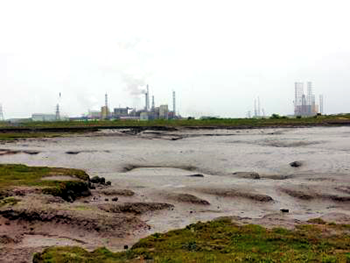
Benjamin Horton is a coastal geologist at Nanyang Technological University in Singapore. He is part of a team that has looked into how past sea-level changes have affected marshes in Great Britain. They did this by examining soil cores. These are cylindrical samples drilled down through many layers of the soil. Those cores hold a record of things like what grew in the area long ago. In this case, the cores also showed the height of ancient sea levels. The team described its findings in Nature Communications last July.
Based on what happened in the past, Horton and his colleagues made some predictions about the future. “As soon as sea level [rise] reaches 7 millimeters (0.28 inch) a year, you’ve got a nine out of 10 chance that the marsh will collapse,” Horton reports. For some parts of Great Britain, that could happen as soon as 2040.
“If you lose the marshes, there are going to be a lot of problems,” he says. With less marshland, coastal areas will erode more quickly. Floods from high tides and storms will be worse. And people will suffer more injuries and property damage.
Spotlight on New York
Hurricane Sandy showed why wetlands matter. The 2012 storm caused nearly $50 billion in flood damage. That’s huge. But the northeastern United States would have had about $625 million more property damage without coastal wetlands, an international team of scientists and engineers reported. They published their calculations in the August 31, 2017 issue of Scientific Reports.
Sandy still caused a lot of damage, though. The storm swamped the coast around New York and New Jersey with about 2.7 meters (9 feet) of water. The southern part of Manhattan flooded. Power went out. Subway stations and tunnels were under water.
Sea level rise will bring more floods like Sandy’s. Before industrial times, floods with water 2.25 meters (7.4 feet) deep used to happen perhaps once every 500 years in the greater New York area, notes Andra Garner. She’s a climate scientist at Rutgers University in New Brunswick, N.J. Now such floods are likely about once every 25 years, she reports. And by 2030 to 2045, such floods could happen every five years or so. That’s the outcome of a November 7, 2017, study that her team published in the Proceedings of the National Academy of Sciences.
Garner’s team made its findings using a host of computer models. Some projected sea level rise. Others estimated storm surges, hurricanes or other factors. “We ultimately end up combining the information from all of these models to get an idea of how the probability and frequency of flooding during a hurricane is changing,” Garner explains. She hopes to use a similar process to see how changes in storms and sea levels could affect flooding in places in places beyond the New York City area.
“I think that the results we found also suggest hope,” Garner adds. The models showed a big spread in possible impacts way into the future. So, “although flooding will likely continue to increase in the future, I believe we have the chance to at least limit how bad that flooding might become,” she says. Action to limit greenhouse gas emissions would be a big step.
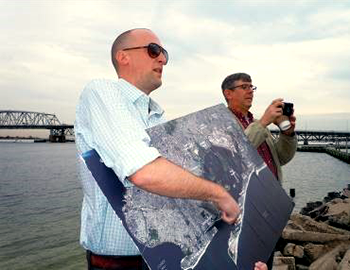
Other, smaller steps can help protect cities, too. Adam Parris heads up the Science and Resilience Institute at Jamaica Bay in Brooklyn, N.Y. Recently, he and others compared two possible ideas for Rockaway Inlet. That’s the bottleneck where the ocean meets Jamaica Bay. One concept would build a big sea gate across the inlet. It could rise up to block incoming water during higher tides and storms. A tiny bit of work would also restore wetlands. The other idea would narrow the inlet and bring back a lot of marshland.
Each strategy would cost a lot — maybe close to $3 billion. But each project could reduce the number of flooded properties by 25 to 30 percent.
Other work is already underway. After Hurricane Sandy, some people elevated buildings to keep them above potential floodwaters. And sandbags are stacked in Brooklyn’s Red Hook neighborhood where they can be deployed quickly to protect homes and businesses. Meanwhile, planners puzzle over how to protect lower Manhattan. Ideas range from a giant barrier across New York Harbor to a big “U” of parkland to absorb incoming water.
Yet if waters rise too high, even very costly plans won’t be sufficient, Parris warns.
Reining in the rise
No matter what we do, sea level rise will continue for several hundred years. Actions now could, however, limit how high the waters will climb.
Propping up some ice shelves might help, says John Moore. He’s a climate scientist at the University of Lapland in Finland and Beijing Normal University in China. Moore and geophysicist Michael Wolovick at Princeton University in New Jersey recently proposed a way to do that job. It involves building large mounds on the sea floor.
The technology exists now, Moore says. “It’s a bit like a flying buttress,” he explains. That’s a feature on some medieval cathedrals. “You build something in front of it and have an arm that sort of pushes against the wall,” Moore explains. “And that holds up the roof.” Mounds on the sea floor could block some warmer water that melts ice sheets from below.
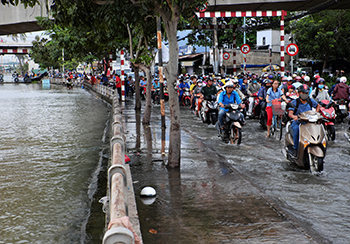
The job would be huge. But so were projects like the Three Gorges Dam in China and the Suez Canal in Egypt. However, Moore adds, “we shouldn’t be starting now to do it.” Studies should investigate where some project would work best. And if too much melt happens, Moore warns, the ice shelves will collapse into the ocean anyway. “Once they get past a tipping point, then they will keep going.”
To prevent that, society should limit greenhouse gas emissions that drive climate change, Garner says. Her work on the New York area showed some scary projections. But it also provides hope. “If we begin acting now to limit climate change,” she says, “we could very well avoid some of the worst-case flooding results we find in our paper.”
“We have very clear evidence,” Sweet at NOAA stresses. “We know that there’s a very tight [link] between temperature, carbon dioxide and future sea levels.” As he sees it, society faces a choice to “pay now or pay later.” And the costs will be much higher later.
“Climate change is very real,” says Cadiente in Newtok. “And in one form or another, it’s affecting all of us all over the world.” The move to Metarvik will let the people of Newtok stay together. And Metarvik will be “a newer, safer place to live,” Caliente says. The ground will be firmer. Clean water will be available. Many berries grow nearby. And people’s favorite hunting areas are not too far away. Cadiente hopes at least one-third of Newtok’s people will be at their new homes by September 2019.
But rising seas threaten many others. A large number may need to move away from their homes, families and friends. That’s true even in places like New York, Parris stresses. And all those people may lose their way of life, as well.
Adapting to sea level rise will be costly. But time is running out to keep things from getting far worse. People have already released half of the emissions that will give a rise of 2 degrees Celsius (3.6 degrees Fahrenheit). It now appears only about 20 or 30 years remain before Earth is committed to much higher levels of sea level rise. By then today’s school kids will be voting, working and maybe raising a family.
“It’s up to the teens now,” Clark stresses. “If they want to prevent the worst-case scenarios from happening, they need to take action.”







